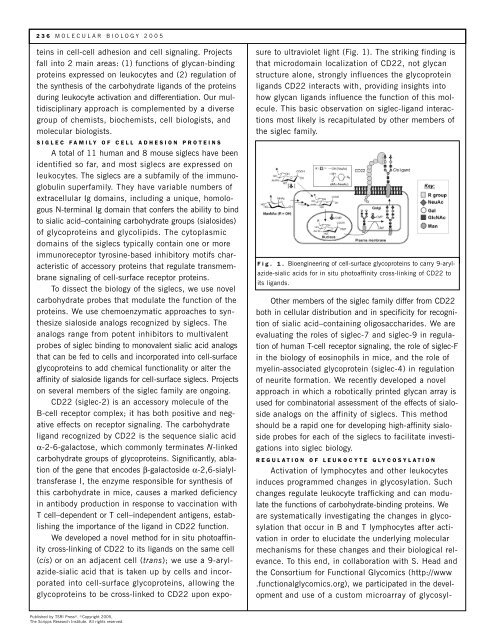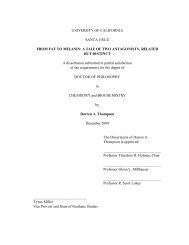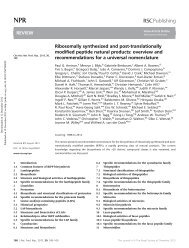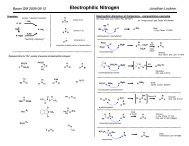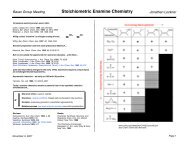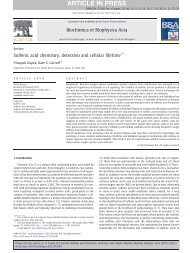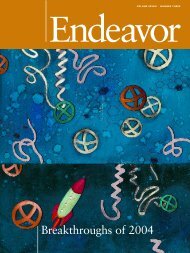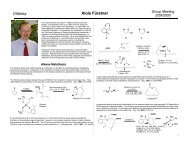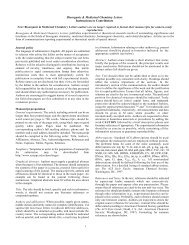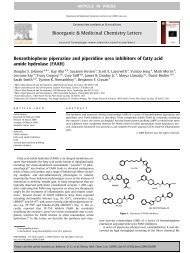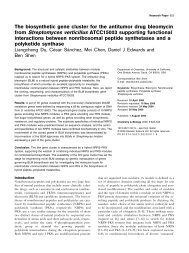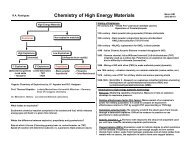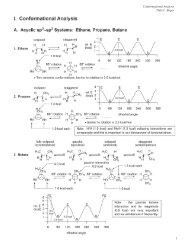Molecular Biology - The Scripps Research Institute
Molecular Biology - The Scripps Research Institute
Molecular Biology - The Scripps Research Institute
Create successful ePaper yourself
Turn your PDF publications into a flip-book with our unique Google optimized e-Paper software.
236 MOLECULAR BIOLOGY 2005<br />
teins in cell-cell adhesion and cell signaling. Projects<br />
fall into 2 main areas: (1) functions of glycan-binding<br />
proteins expressed on leukocytes and (2) regulation of<br />
the synthesis of the carbohydrate ligands of the proteins<br />
during leukocyte activation and differentiation. Our multidisciplinary<br />
approach is complemented by a diverse<br />
group of chemists, biochemists, cell biologists, and<br />
molecular biologists.<br />
SIGLEC FAMILY OF CELL ADHESION PROTEINS<br />
A total of 11 human and 8 mouse siglecs have been<br />
identified so far, and most siglecs are expressed on<br />
leukocytes. <strong>The</strong> siglecs are a subfamily of the immunoglobulin<br />
superfamily. <strong>The</strong>y have variable numbers of<br />
extracellular Ig domains, including a unique, homologous<br />
N-terminal Ig domain that confers the ability to bind<br />
to sialic acid–containing carbohydrate groups (sialosides)<br />
of glycoproteins and glycolipids. <strong>The</strong> cytoplasmic<br />
domains of the siglecs typically contain one or more<br />
immunoreceptor tyrosine-based inhibitory motifs characteristic<br />
of accessory proteins that regulate transmembrane<br />
signaling of cell-surface receptor proteins.<br />
To dissect the biology of the siglecs, we use novel<br />
carbohydrate probes that modulate the function of the<br />
proteins. We use chemoenzymatic approaches to synthesize<br />
sialoside analogs recognized by siglecs. <strong>The</strong><br />
analogs range from potent inhibitors to multivalent<br />
probes of siglec binding to monovalent sialic acid analogs<br />
that can be fed to cells and incorporated into cell-surface<br />
glycoproteins to add chemical functionality or alter the<br />
affinity of sialoside ligands for cell-surface siglecs. Projects<br />
on several members of the siglec family are ongoing.<br />
CD22 (siglec-2) is an accessory molecule of the<br />
B-cell receptor complex; it has both positive and negative<br />
effects on receptor signaling. <strong>The</strong> carbohydrate<br />
ligand recognized by CD22 is the sequence sialic acid<br />
α-2-6-galactose, which commonly terminates N-linked<br />
carbohydrate groups of glycoproteins. Significantly, ablation<br />
of the gene that encodes β-galactoside α-2,6-sialyltransferase<br />
I, the enzyme responsible for synthesis of<br />
this carbohydrate in mice, causes a marked deficiency<br />
in antibody production in response to vaccination with<br />
T cell–dependent or T cell–independent antigens, establishing<br />
the importance of the ligand in CD22 function.<br />
We developed a novel method for in situ photoaffinity<br />
cross-linking of CD22 to its ligands on the same cell<br />
(cis) or on an adjacent cell (trans); we use a 9-arylazide-sialic<br />
acid that is taken up by cells and incorporated<br />
into cell-surface glycoproteins, allowing the<br />
glycoproteins to be cross-linked to CD22 upon expo-<br />
Published by TSRI Press ®. ©Copyright 2005,<br />
<strong>The</strong> <strong>Scripps</strong> <strong>Research</strong> <strong>Institute</strong>. All rights reserved.<br />
sure to ultraviolet light (Fig. 1). <strong>The</strong> striking finding is<br />
that microdomain localization of CD22, not glycan<br />
structure alone, strongly influences the glycoprotein<br />
ligands CD22 interacts with, providing insights into<br />
how glycan ligands influence the function of this molecule.<br />
This basic observation on siglec-ligand interactions<br />
most likely is recapitulated by other members of<br />
the siglec family.<br />
Fig. 1. Bioengineering of cell-surface glycoproteins to carry 9-arylazide-sialic<br />
acids for in situ photoaffinity cross-linking of CD22 to<br />
its ligands.<br />
Other members of the siglec family differ from CD22<br />
both in cellular distribution and in specificity for recognition<br />
of sialic acid–containing oligosaccharides. We are<br />
evaluating the roles of siglec-7 and siglec-9 in regulation<br />
of human T-cell receptor signaling, the role of siglec-F<br />
in the biology of eosinophils in mice, and the role of<br />
myelin-associated glycoprotein (siglec-4) in regulation<br />
of neurite formation. We recently developed a novel<br />
approach in which a robotically printed glycan array is<br />
used for combinatorial assessment of the effects of sialoside<br />
analogs on the affinity of siglecs. This method<br />
should be a rapid one for developing high-affinity sialoside<br />
probes for each of the siglecs to facilitate investigations<br />
into siglec biology.<br />
REGULATION OF LEUKOCYTE GLYCOSYLATION<br />
Activation of lymphocytes and other leukocytes<br />
induces programmed changes in glycosylation. Such<br />
changes regulate leukocyte trafficking and can modulate<br />
the functions of carbohydrate-binding proteins. We<br />
are systematically investigating the changes in glycosylation<br />
that occur in B and T lymphocytes after activation<br />
in order to elucidate the underlying molecular<br />
mechanisms for these changes and their biological relevance.<br />
To this end, in collaboration with S. Head and<br />
the Consortium for Functional Glycomics (http://www<br />
.functionalglycomics.org), we participated in the development<br />
and use of a custom microarray of glycosyl-


